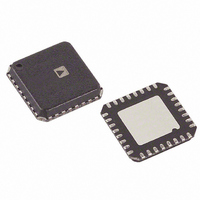AD9245BCPZ-80 Analog Devices Inc, AD9245BCPZ-80 Datasheet - Page 19

AD9245BCPZ-80
Manufacturer Part Number
AD9245BCPZ-80
Description
IC ADC 14BIT 80MSPS 3V 32-LFCSP
Manufacturer
Analog Devices Inc
Datasheet
1.AD9245BCPZ-80.pdf
(32 pages)
Specifications of AD9245BCPZ-80
Data Interface
Parallel
Number Of Bits
14
Sampling Rate (per Second)
80M
Number Of Converters
3
Power Dissipation (max)
414mW
Voltage Supply Source
Single Supply
Operating Temperature
-40°C ~ 85°C
Mounting Type
Surface Mount
Package / Case
32-VFQFN, CSP Exposed Pad
Resolution (bits)
14bit
Sampling Rate
80MSPS
Input Channel Type
Differential, Single Ended
Supply Voltage Range - Analog
2.7V To 3.6V
Supply Current
122mA
Lead Free Status / RoHS Status
Lead free / RoHS Compliant
For Use With
AD9245BCP-80EBZ - BOARD EVAL FOR AD9245BCP-80AD9245BCP-40EBZ - BOARD EVAL FOR AD9245BCP-40AD9245BCP-20EBZ - BOARD EVAL FOR AD9245BCP-20
Lead Free Status / RoHS Status
Lead free / RoHS Compliant, Lead free / RoHS Compliant
Available stocks
Company
Part Number
Manufacturer
Quantity
Price
Company:
Part Number:
AD9245BCPZ-80
Manufacturer:
AD
Quantity:
197
Company:
Part Number:
AD9245BCPZ-80
Manufacturer:
ADI
Quantity:
1
Part Number:
AD9245BCPZ-80
Manufacturer:
ADI/亚德诺
Quantity:
20 000
The SHA can be driven from a source that keeps the signal
peaks within the allowable range for the selected reference
voltage. The minimum and maximum common-mode input
levels are defined as
The minimum common-mode input level allows the AD9245 to
accommodate ground referenced inputs.
Although optimum performance is achieved with a differential
input, a single-ended source can be applied to VIN+ or VIN–.
In this configuration, one input accepts the signal, while the
opposite input is set to midscale by connecting it to an
appropriate reference. For example, a 2 V p-p signal can be
applied to VIN+ while a 1 V reference is applied to VIN–. The
AD9245 then accepts an input signal varying between 2 V and
0 V. In the single-ended configuration, distortion performance
can degrade significantly as compared to the differential case.
However, the effect is less noticeable at lower input frequencies.
Differential Input Configurations
As previously detailed, optimum performance is achieved while
driving the AD9245 in a differential input configuration. For
baseband applications, the AD8351 differential driver provides
excellent performance and a flexible interface to the ADC. The
output common-mode voltage of the AD8351 is easily set to
AVDD/2, and the driver can be configured in a Sallen-Key filter
topology to provide band limiting of the input signal.
2V p-p
At input frequencies in the second Nyquist zone and above, the
performance of most amplifiers is not adequate to achieve the
true performance of the AD9245. This is especially true in IF
undersampling applications where frequencies in the 70 MHz to
100 MHz range are being sampled. For these applications,
differential transformer coupling is the recommended input
configuration. The value of the shunt capacitor is dependent on
the input frequency and source impedance and should be
reduced or removed. An example is shown in Figure 41.
VCM
VCM
Figure 40. Differential Input Configuration Using the AD8351
50Ω
MIN
MAX
0.1μF
25Ω
=
=
VREF
(
0.1μF
25Ω
AVDD
2
1.2kΩ
AD8351
2
+
VREF
1kΩ
)
1kΩ
0.1μF
0.1μF
33Ω
20pF
33Ω
VIN+
VIN–
AD9245
AGND
AVDD
Rev. D | Page 19 of 32
2V p-p
The signal characteristics must be considered when selecting
a transformer. Most RF transformers saturate at frequencies
below a few MHz, and excessive signal power can also cause
core saturation, which leads to distortion.
Single-Ended Input Configuration
A single-ended input can provide adequate performance in
cost-sensitive applications. In this configuration, there is a
degradation in SFDR and distortion performance due to the
large input common-mode swing (see Figure 13). However, if
the source impedances on each input are matched, there should
be little effect on SNR performance. Figure 42 details a typical
single-ended input configuration.
2V p-p
CLOCK INPUT CONSIDERATIONS
Typical high speed ADCs use both clock edges to generate a
variety of internal timing signals, and as a result can be sensitive
to clock duty cycle. Commonly a 5% tolerance is required on the
clock duty cycle to maintain dynamic performance characteristics.
The AD9245-80 and AD9245-65 contain a clock duty cycle
stabilizer (DCS) that retimes the nonsampling edge, providing an
internal clock signal with a nominal 50% duty cycle. This allows a
wide range of clock input duty cycles without affecting the
performance of the AD9245. As shown in Figure 21, noise and
distortion performance is nearly flat for a 30% to 70% duty cycle
with the DCS on.
The duty cycle stabilizer uses a delay-locked loop (DLL) to
create the nonsampling edge. As a result, any changes to the
sampling frequency require approximately 100 clock cycles to
allow the DLL to acquire and lock to the new rate.
Figure 41. Differential Transformer-Coupled Configuration
49.9 Ω
49.9Ω
Figure 42. Single-Ended Input Configuration
10 μ F
+
0.33 μ F
0.1μF
0.1 μ F
1k Ω
1k Ω
1k Ω
1k Ω
1kΩ
1kΩ
33Ω
33Ω
20pF
20pF
33 Ω
33 Ω
VIN+
VIN–
VIN+
VIN–
AD9245
AD9245
AVDD
AGND
AGND
AVDD
AD9245













